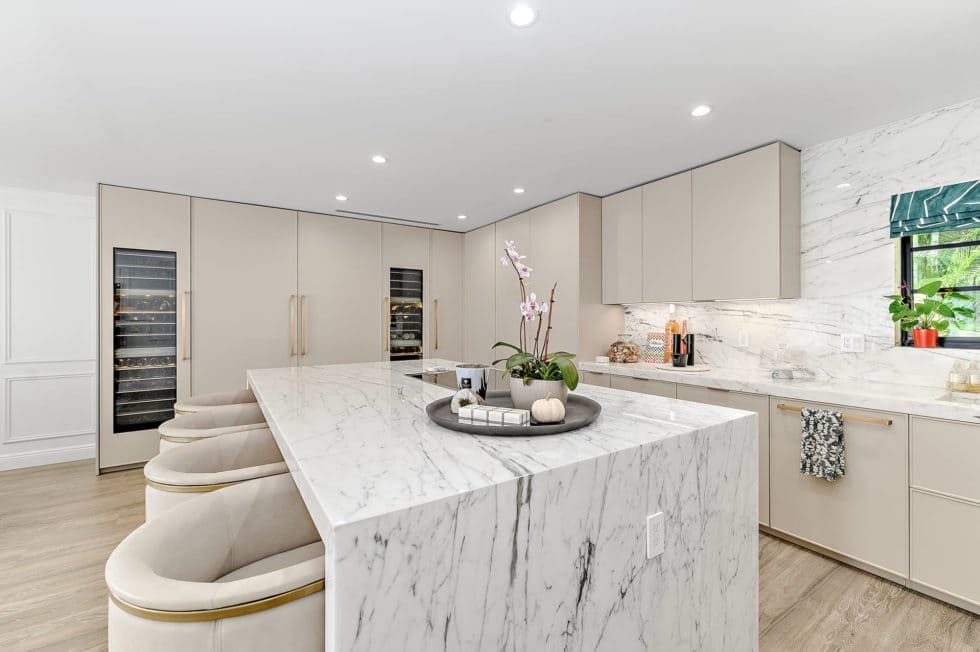Large luxury kitchen designs are integrated with designer materials, advanced technology, and personalized details to produce an area of both refinement and functionality. It’s not a simple area where one cooks; it’s a central gathering place for entertaining, unwinding, and indulging in the culinary arts. Important considerations of high-end kitchen design especially in upscale kitchens are centered on quality, aesthetics, and high-tech features, all while yielding a smooth, integrated appearance.
There are many factors to consider when designing a luxury modern kitchen design and luxury designer kitchen, especially when it comes to high-end kitchens. but some of the most important elements include the following:
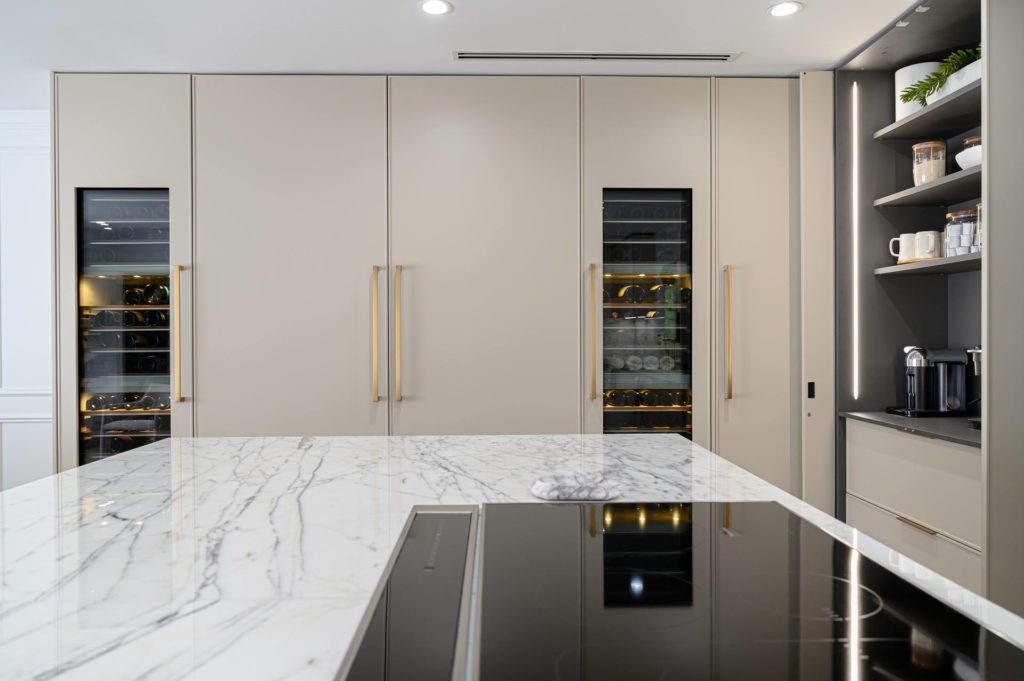
modern kitchen designs
-
- Custom cabinetry: Custom cabinets provide both style and function, and we can design them to fit any space, making them a perfect addition to a luxury kitchen design.
- High-end appliances: From refrigerators and ovens to dishwashers and microwaves, choosing high-end appliances will ensure your kitchen is always up to the task, especially with luxury kitchen design in mind.
- Designer countertops: Marble, granite, quartz, or another material? The choice is yours!
- Backsplashes & floors: Custom backsplashes and floors can really make a luxury contemporary fancy design, especially in high-end kitchens, pop
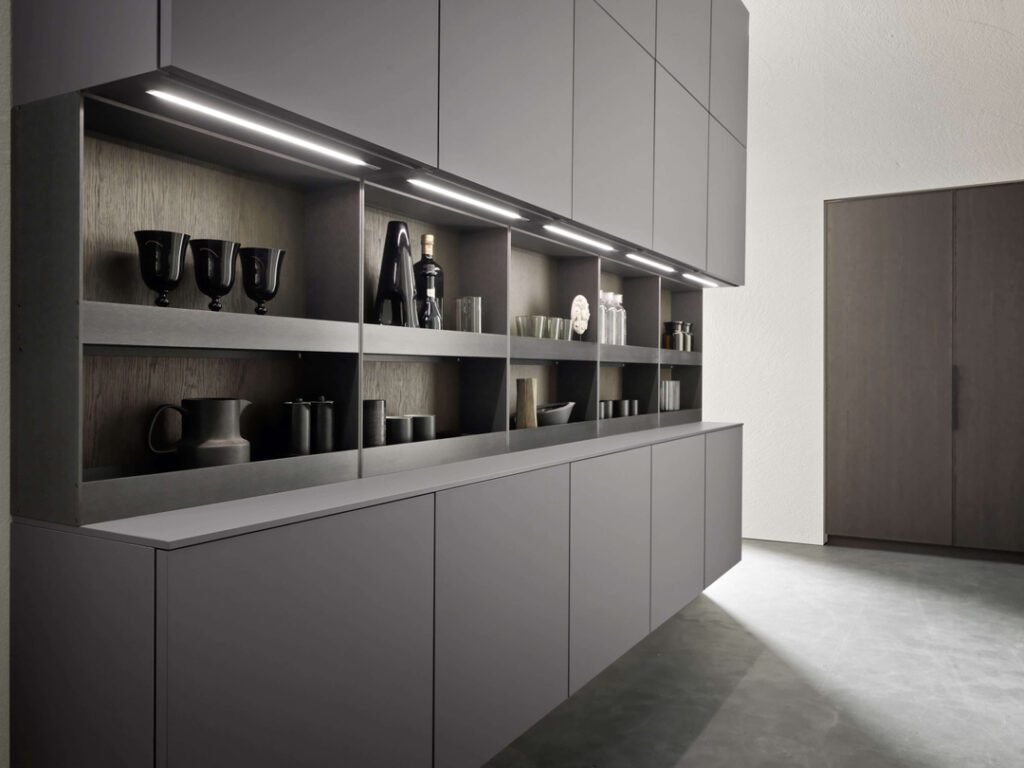
luxury kitchen design
If you’re ready to take your kitchen to the next level, contact PEDINI Miami today. We’ll work with you to create custom kitchen designs with Luxury kitchen appliances that are perfect for your home..
What makes a kitchen look luxury?
A luxury modern kitchen design is defined by high-quality materials, lighting, Appliances, and colors. White & cream colors look expensive and elegant. A luxury modern kitchen, including luxury kitchen design, typically offers generous amounts of space. A well-thought-out layout with plenty of storage, a countertop area, and room to move around contribute to a luxurious feel, providing both functionality and visual charm. The adoption of slim, clean cabinetry, state-of-the-art technology, and well-chosen finishes further adds to the overall sophistication of luxury home kitchens, providing an inviting and glamorous ideal room, feel positive vibes in your living room as well as you can have entertainment with friends and family.
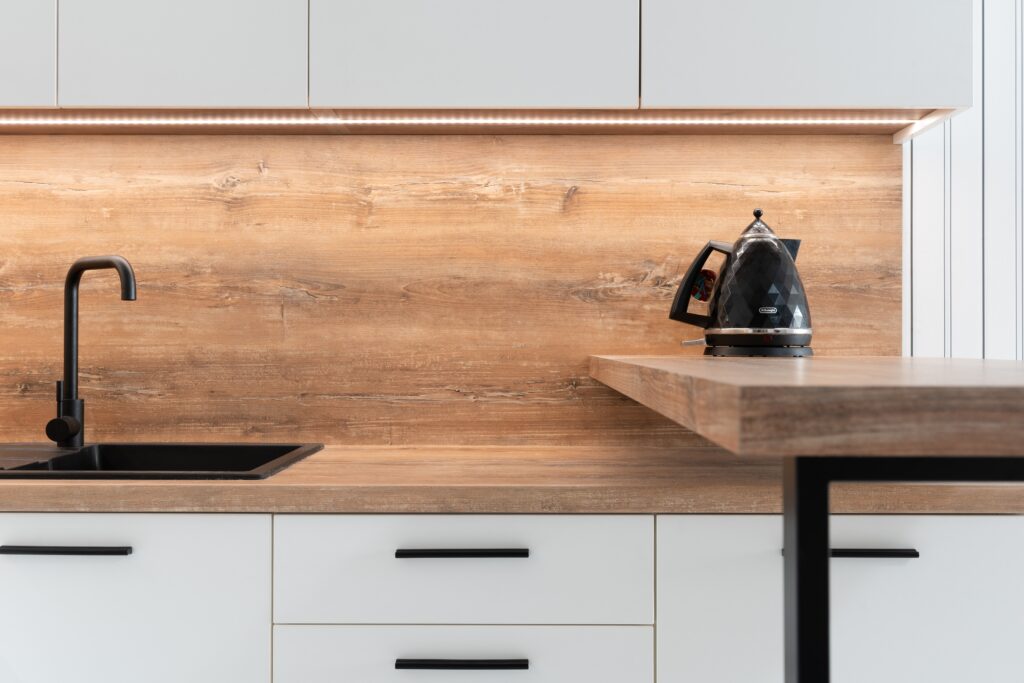
modern kitchen designs
What is the most expensive kitchen design?
The ‘Fiore di Cristallo’ kitchen is known as the most expensive fancy kitchens in the world, setting the standard for luxury kitchen design. It was created by renowned Italian designer Claudio Celiberti in collaboration with the luxury designer kitchens brand “Pricci” in 2010.The Fiore di Cristallo large luxury kitchen design gained recognition for its opulent and extravagant features, as well as its hefty price tag, which was reported to be around $1.6 million.
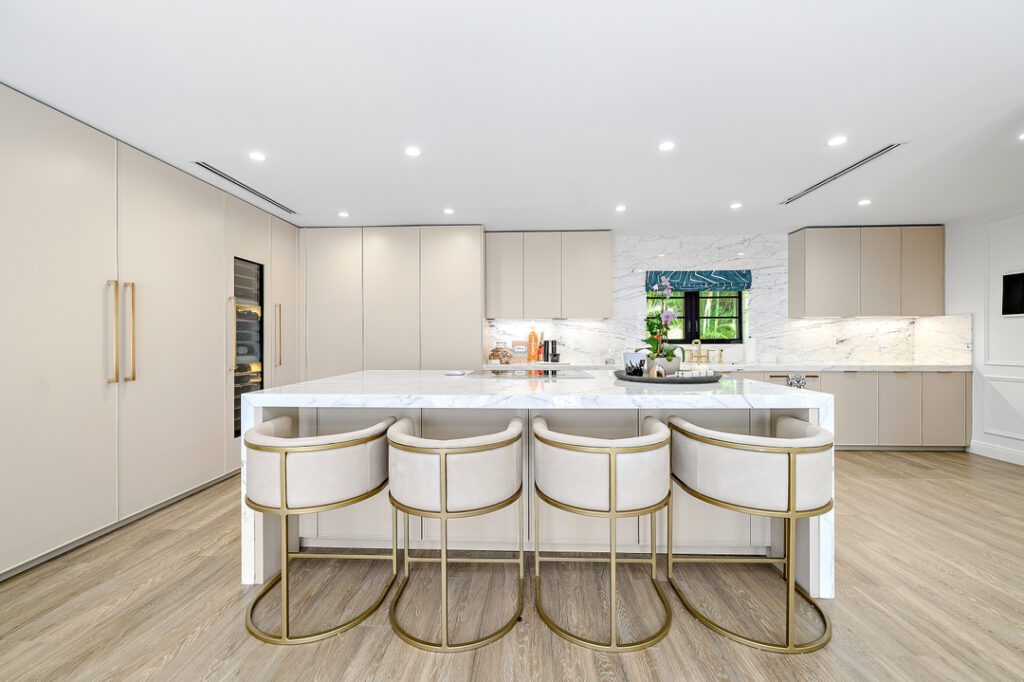
modern kitchen ideas
How to create a luxury kitchen?
Creating a involve careful planning, attention to detail, and the incorporation of high-quality materials and design elements, such as sleek cabinetry, state-of-the-art appliances, sophisticated lighting, and a harmonious color palette that reflects both functionality and aesthetic appeal.
Define your vision.
Layout and space planning
High-quality materials
Lighting and ambiance
Integrated technology
Finishing touches
The benefits of a custom kitchen
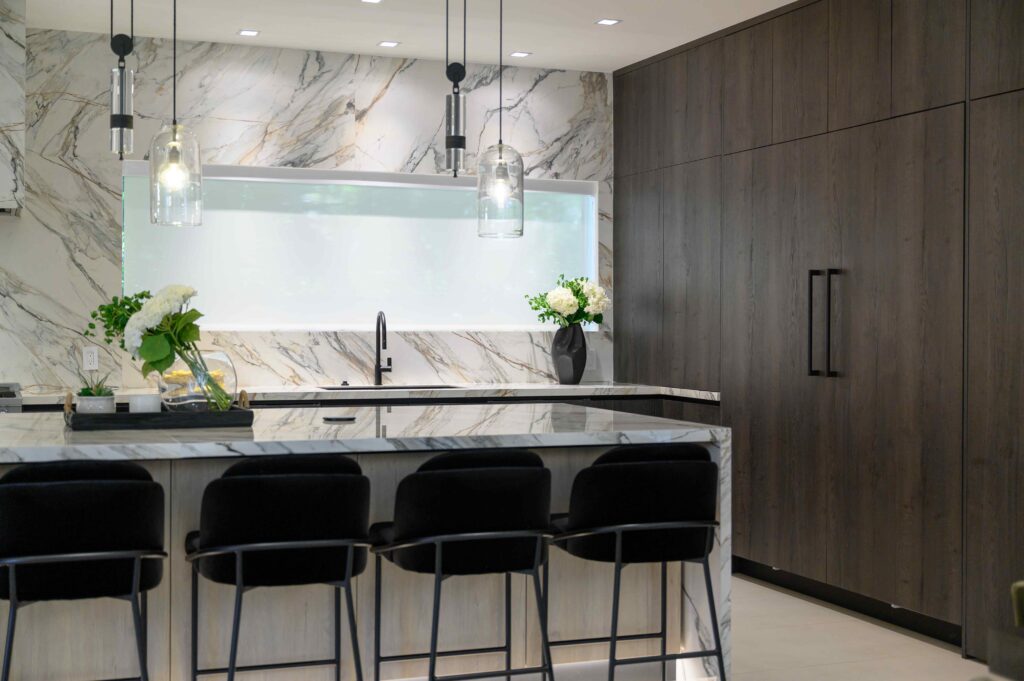
modern luxury interior design
There are many benefits that come with having a custom kitchen, both form and function. Installation of sleek, minimalist cabinetry, advanced technology, and thoughtfully chosen finishes further enhances the overall elegance of luxury home kitchens, providing an appealing and chic room that is suitable for daily living as well as entertaining.:
-
- Increased home value: A luxury kitchen design will add value to your home and make it more appealing to potential buyers.
- Improved functionality: Custom large luxury kitchen designs are designed to be both beautiful and functional. We’ll work with you to find the perfect layout for your space including high-end kitchens.
- Endless design possibilities: When you work with PEDINI Miami, the sky’s the limit in design. We can help you create a high-end kitchens that are perfect for your home.
How to choose the right company for your kitchen renovation
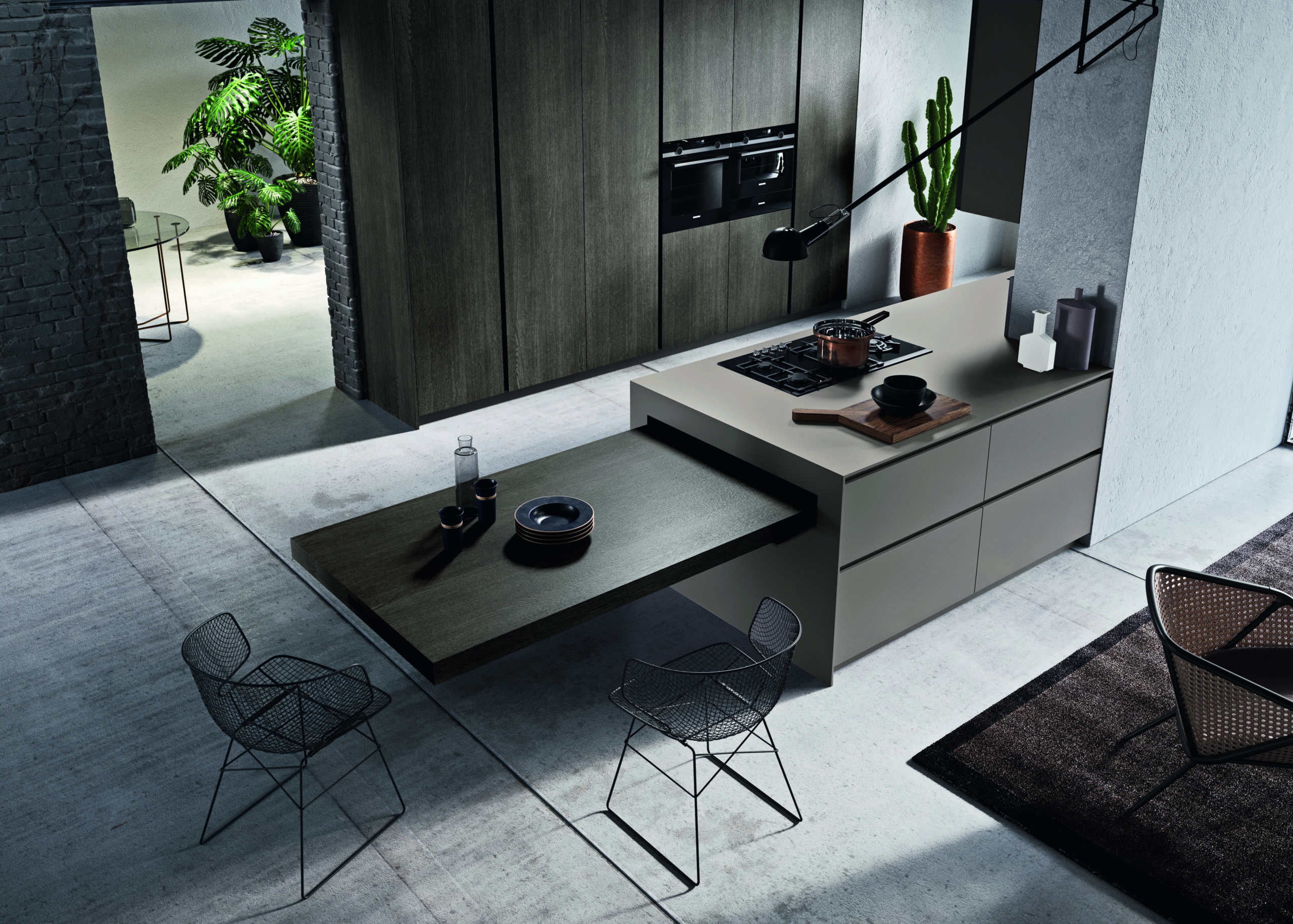
luxury kitchen
When choosing a company to renovate your kitchen, selecting one with experience is essential. At PEDINI Miami, We’ve worked with some of the most prestigious architects and interior designers in the world, and our team is passionate about creating beautiful and functional spaces for luxury home kitchens.
In addition to experience, it’s also important to choose a company that uses high-quality materials. At PEDINI Miami, we provide the Best Kitchen Design Services and Remodeling services, and we only use the best materials available on the market. We believe using quality materials is the key to creating a high-end kitchen that will stand the test of time, offering not only aesthetic appeal but also durability, functionality, and long-term value for our clients.
Tips for designing your perfect kitchen
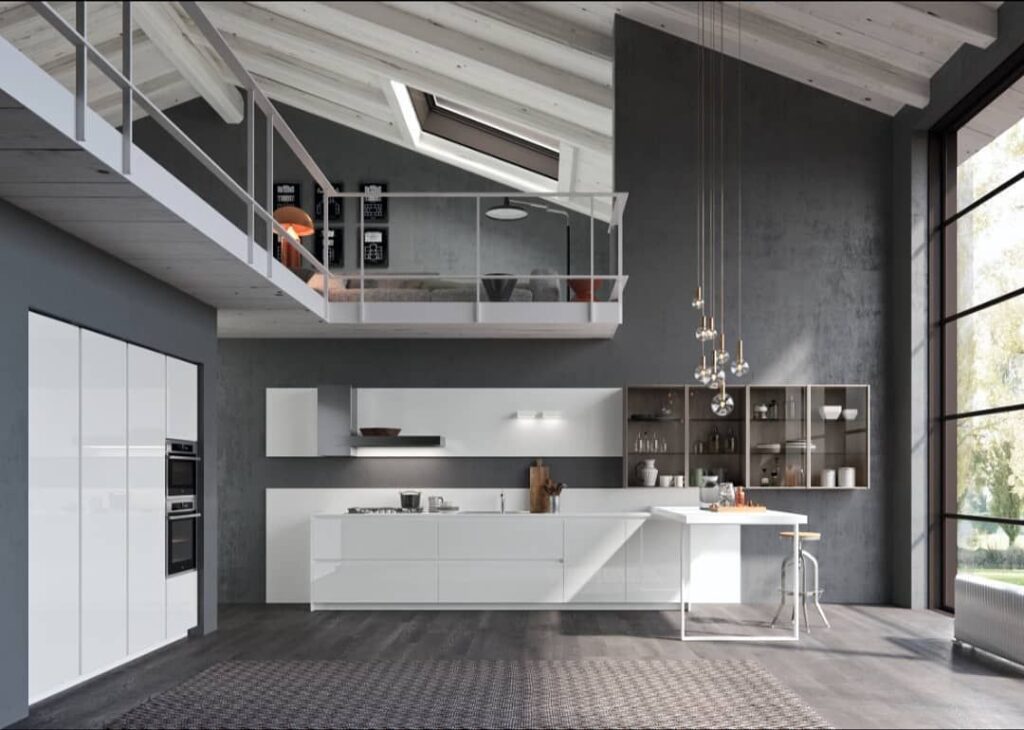
contemporary kitchen design
Not sure where to start when it comes to designing your dream modern luxury kitchen designs? Let us help guide you through every step, from choosing the perfect layout to selecting stylish, functional finishes that reflect your personality and lifestyle Here are a few tips:
1. Define your style: Do you want a modern kitchen or a traditional one, or a high-end kitchen? What colors do you want to use? Answering these questions will help narrow down your options for luxury home kitchens and simplify the design process.
2. Think about function: A luxury kitchen design isn’t just about looks. It’s also about function. Think about how you use your high-end kitchens and what features would make your life easier.
3. Create a wish list: Once you have an idea of what you want, start creating a wish list of all the features you’d like to have in your large luxury kitchen designs. This will help you narrow down your options and ensure you get everything you want.
4. Work with a professional: designing a large luxury kitchen can be complicated. That’s why it’s crucial to work with a professional who can help you navigate the design process and ensure your high-end kitchen turns out exactly the way you want it.
A vision of a focal point
Some things are more important than others and a custom luxury kitchen requires a dramatic feature to attract attention at first glance. The other salient features blend in or complement according to the theme. Appliances, cabinets, tiles, colors, and designs could set the mood or make a resounding statement. Marble islands or countertops often attract attention through sheer gloss or color, like in travertine. Some artistic types may install a painting or sculpture that tells a vivid story.
Consider a large island quite essential
Assuming that the dream luxury kitchen is spacious enough, go one step further with a mighty island and perhaps a smaller one too. Multifarious advantages all add up in a cute little island space that is soon becoming a gathering and socializing heaven. Not all meetings happen at parties and picnics. Whether it is a cooking lesson or gossip session, that island provides fertile ground for a series of activities that would otherwise seem impossible.
A spacious kitchen island serves as the central hub for organizing gatherings, allowing for the efficient arrangement of essentials such as napkins, utensils, dishes, and food containers. Its ample countertop space facilitates seamless party planning and preparation, ensuring all necessary items are within easy reach.
The whole world is a canvas
Custom luxury kitchen design does require getting off the monotony. Look around and you find pictures everywhere, whether electronic or artistic. Rather than drab surfaces, why not make everything a little livelier? Wallpapers come in a million designs. Graphic tiles, whether geometric 3D shapes or stunning nature patterns, bring kitchen environments to life. Originality could be stressed, and walls and cabinets could show a single silhouette or many smaller images, reflecting whatever the owner is intensely fond of. Remember, each area of your home can feature a unique array of decorations, color schemes, and meanings. Depending on its role in your home’s design philosophy, the kitchen can become an enchanting showcase of culture.
Floral designs, perhaps along with leaves, flowers, and fruit, arouse intense interest universally and deserve to be figured somewhere in the kitchen plan.
The earthy charm
Amidst the idea of returning to nature or human roots in villages, preserving the earth, and sustainability, terracotta and other natural substances like wood bring a tranquil warmth. Hardwood floors or natural stone are exquisite possibilities. Stone is very durable, and slate has a unique beauty. Bamboo would make exotic floors and countertops. Chairs or light fixtures crafted from natural materials exude elegance, reminding us of nature’s raw beauty.
Pedini Miami helps design a custom luxury kitchen that looks and feels unique, reflecting the wishes and the personality, grace, and style of the customer. Work with experienced specialized designers and use pictures and videos, magazines, and objects to explain abstract ideas. When all is said and done, expect a breathtaking luxury kitchen that surpasses every expectation.
Conclusion:
A bespoke luxury kitchen design is an investment in function and style alike, combining high style with advanced technology and luxury materials. From bespoke cabinetry to advanced appliances and refined finishes, each aspect is crafted to deliver a space that suits your lifestyle while upgrading your home’s look, particularly in luxury home kitchens. Whether you are designing a cooking space for creative expression or a space to host, modern luxury kitchen design maintains both functionality and beauty. Working with skilled designers such as PEDINI Miami can help you achieve your vision and create the ultimate luxury home kitchen that elevates your lifestyle and provides lasting value to your residence.

